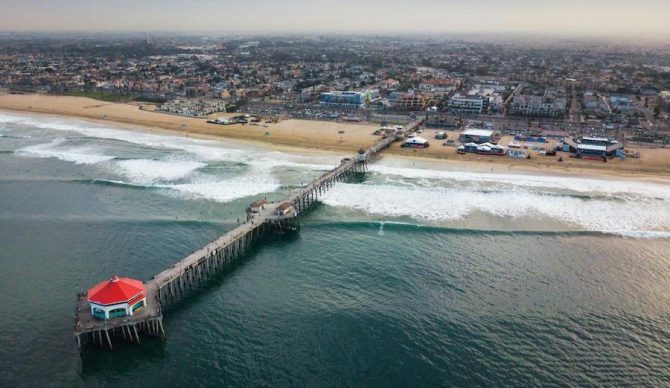
You’ve probably never seen a webcast from this spot. Never. Ever. Photo: WSL
For all the talk about rampant coastal development and subsequent loss of precious surf spots, man has actually done a much better job of creating premier waves than destroying them. While there certainly are some unfortunate examples of lost spots like Santa Monica’s P.O.P. Pier (both man-made and extinct) Ponta Delgada, on the Atlantic Island of Madeira, Petacalco, on Mainland Mexico and Bastion Point, Australia, in California, for example, surfers old enough to remember are still wringing their hands over Killer Dana and Stanleys, both destroyed (harbor and freeway offramp) over half a century ago. Chances are, just about no matter where you surf, you’ve probably ridden more waves created or enhanced by man’s hand than have any snatched away. Here’s a list of some of the most significant from my POV.
10. HUNTINGTON BEACH PIER
I once interviewed a top coastal engineer at the U.S. Army Corps of Engineers to have a nagging question answered: why are the waves on the south and north side of the Huntington Beach Pier so consistently rideable, and quite often very good, when piers just to the south and north aren’t. Know what he told me? “We just don’t know,” he said, pointing to how the H.B. Pier stumped even their most sophisticated analytical computers. “There are just too many data points to consider. All we know is that for some reason, that pier has created better waves than any other on the coast.” Hey, he said it, I didn’t.

Sebastian Inlet has changed a lot over the years. Photo: Florida Pro
9. FIRST PEAK SEBASTIAN INLET
In 1970, Floridian engineers had absolutely no interest in the outcome of their finished work on a 500-foot extension of Sebastian Inlet’s north jetty other than keeping the inlet’s mouth from shoaling. Happily, the unintentional consequence was the creation of a near-shore refraction pattern that saw normally tepid Florida wind swell bounce off the new section of jetty and back into itself, forming a steep, hollow, wedge-like wave that very quickly became the East Coast’s most famous surf spot. While delighted Floridian surfers rejoiced, Floridian fishermen, good ‘ol boys all and heretofore the Inlet’s only local denizens, responded by casting epithets and lead sinkers at surfers floating next to the new jetty, convinced that, while these longhaired interlopers were most probably smoking pot and burning American flags, they were most certainly spooking all the snook and speckled trout. Good luck, guys: over the decades more world-class surfers have emerged from this humble wedge than all the other U.S. East Coast waves combined.
8. LA BARRE (POSTHUMOUS)
When in the late 1960s, French engineers began constructing jetties at the mouth of La Cǒte Basque’s Adour River, the intention being to facilitate ship passage to the city of Bayonne upstream, the inadvertent result was the creation of a remarkably static sandbar on the jetty’s south side that, for a few years in the late ‘60s and early ‘70s, fostered the hippest surf spot on the planet. Mix a counter-culture revolution in full swing with perfect lefts, warm water, new shortboards and cheap French wine and you had a happening scene that attracted surfers from all over the globe, including luminaries like Mark Martinson, Bill Hamilton, Keith Paull, Nat Young, Wayne Lynch, Brad McCaul, Gerry Lopez, Mike Diffenderfer, Jeff Hakman…well, you get the picture. Unfortunately, it didn’t last long. The extending of the jetties continued, eventually spoiling the sandbar – by ’72 it was gone. Man gaveth, and man tooketh away. Hélas!
7. HOLLYWOOD-BY-THE-SEA
In the early 1920s, film production crews from nearby Burbank, California, began making the trip out to the deserted Oxnard dunes, the sandy desolation standing in for the Saharan Desert in such blockbuster films as The Sheik, starring heartthrob Rudolph Valentino. Over the years savvy real estate developers packaged and subdivided the beaches as “Hollywood-by-the-Sea” and Silverstrand” (as in, ‘silver screen’), two names that would become infamous in California surfing. Not for some time, however. Period photos of the strand show miles of nondescript, closeout beachbreak. But when in 1960 the U.S. Army Corp of Engineers cut a waterway and built jetties for its creation of the Channel Islands Harbor, depositing dredged sand to the north and south of the jetties (deliberately designed as sand traps), those formerly unimpressive closeouts were transformed into some of the world’s best beachbreak barrels. Let the window bashing and tire slashing begin!
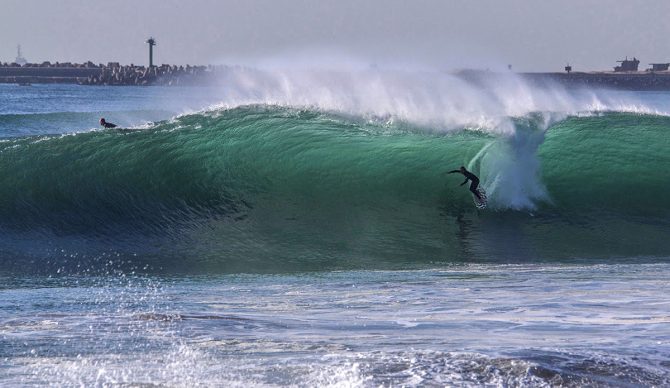
New Pier perfection and Rick Basnett on a bomb. Photo: FLANAGAN
6. NEW PIER
Located along Durban, South Africa’s city shore front, the surf spot known as Bay of Plenty was once one of this wave-rich country’s premier breaks – it was here, in the sand-bottom tubes that built up off its jetty (man-made, thank you) that the legendary Shaun Tomson first learned how to ride the barrel. But that’s not the story. In the mid-1980s, construction began on a new pier, placed between Bay of Plenty and Dairy Beach to the south. And wouldn’t you know it, due to some vagary of littoral sand flow and subsequent sandbar creation the epic tubes eventually moved 100 yards south to that new pier, creating an even better, more consistent break somewhat uncreatively dubbed “New Pier.” Nurturing the likes of S.A. stars Twiggy Baker and Jordy Smith, New Pier probably has more super-hot locals, per capita, than any other surf spot on earth.
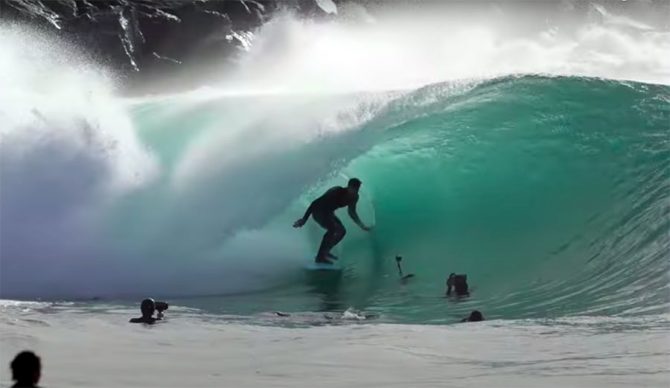
The Wedge that no one could predict back in the 1930s.
5. WEDGE
In December, 1934, dredging and the construction commenced at the entrance to Newport Beach, California’s mostly natural harbor, with the west jetty extension continuing until Dedication Day on May 26, 1936. Meaning it was quite possible that the proud city fathers had yet to experience a sizable chubasco swell that season. So just imagine their dismay when they finally did, witnessing the extraordinary affect that west jetty, positioned just so, had on the big swells lumbering in from the south, magnifying an already considerable rebound effect to create, well, a monster wave, really. A back-breaking, neck-snapping, surf trunk-ripping, sand-packing monster. First came the bodysurfers, then the bellyboarders, then the kneeboarders, then the bodyboarders, then the skimmers (calling people off waves from the shore) and finally the conventional board surfers, all to try their hand at surviving a short ride at one of the sport’s most spectacular waves.

Mr. Mason Ho at firing Ala Moana. Photo: Screenshot
4. ALA MOANA
When in the 1920s Hawaii’s Territorial Government began construction of the Ala Wai Harbor, which included dredging a path to the sea for the man-made Ala Wai Canal, they couldn’t have had any idea that by blasting through the offshore coral reef they had also created one of surfing’s most influential surf spots. And one of its most underrated. Because it’s been in the left-breaking, essentially man-made reef pass lefts, that so many of the sport’s innovations found free expression. Modern tube-riding in the early 1960s (thank you, Conrad Canha), late ‘60s refinement of the mini-gun (thank you, Gerry Lopez and Reno Abellira) and the even-more-modern tube ride (again, thanks, Gerry), cutting-edge mid-70s, high-performance surfing (thanks, Ben Aipa, Michael Ho, Larry Bertlemann, Buttons, Liddell and a host of other hot locals)…and whatever Mason Ho is doing out there today. Truth is, we owe a lot to the old coral killing bastards who build that channel.
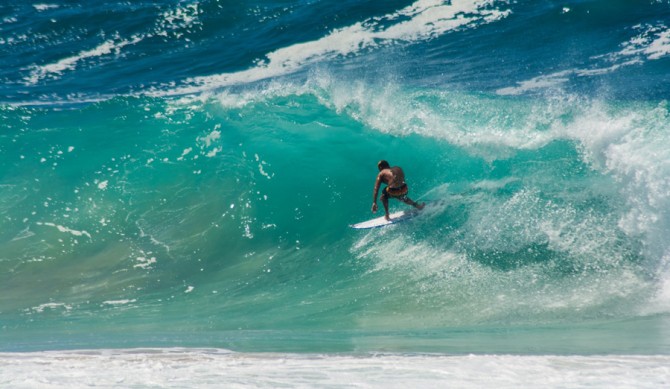
The weirdness that is the Superbank.
3. SUPERBANK
Plenty of coastlines around the world can boast of killer surf spots, but only Australia’s Gold Coast can lay claim to a serial killer. I’m talking about the Snapper Rocks Superbank, that littoral phenomena created by the relatively recently reconfigured dredging of the Tweeds Head River mouth, which has produced some of the most amazingly long, hollow sand-bottom tubes ever seen, yet has done so by essentially murdering three formerly adjacent surf spots: Rainbow Bay, Greenmount and, for a time, Kirra. This capital crime paid off for a handful of Coolie Kids, including the likes of world champions Mick Fanning, Joel Parkinson and Stephanie Gilmore, who occasionally manage to get a few epic barrels to themselves from behind the Rock. But for the rest of the Goldie’s surfing population, including those displaced Rainbow Bay, Greenmount and Kirra devotees who now have no choice but to cram into this new contiguous lineup, it’s a nightmare scenario of senseless drop-ins in the first-degree.
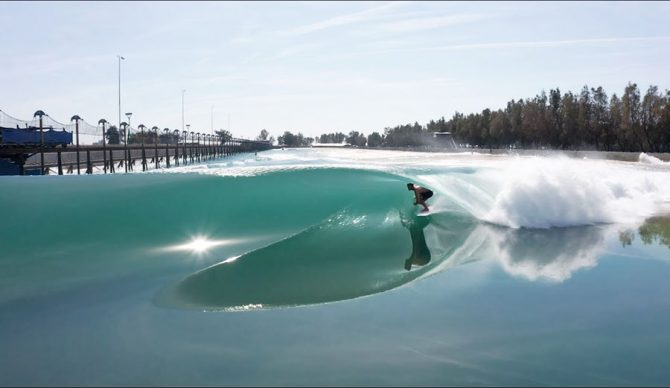
John John Florence, on a man-made gem. Photo: Screenshot
2. THE SURF RANCH
One-hundred percent, man-made version of South Africa’s Cape St. Francis, as depicted in 1965’s The Endless Summer, the sport’s first mass-marketed “perfect wave.” Ignore all the sour grapes from cynical surf journos and catty commenters – if everyone could surf this wave, everyone would surf this wave…and love it. Enough said about that.
1. BEN GRAVY’S LATEST FERRY WAKE
Pretty sure it’s somewhere in Scandinavia, but that’s no matter: getting barreled on a chest-high displacement wave rippling off the stern of a big automobile ferry is not only a triumph of imagination, but perhaps the most unlikely, and delightfully unique man-made wave experiences to be had in any body of water. No doubt a channel-side surf camp, complete with current ferry schedules, comes next.

